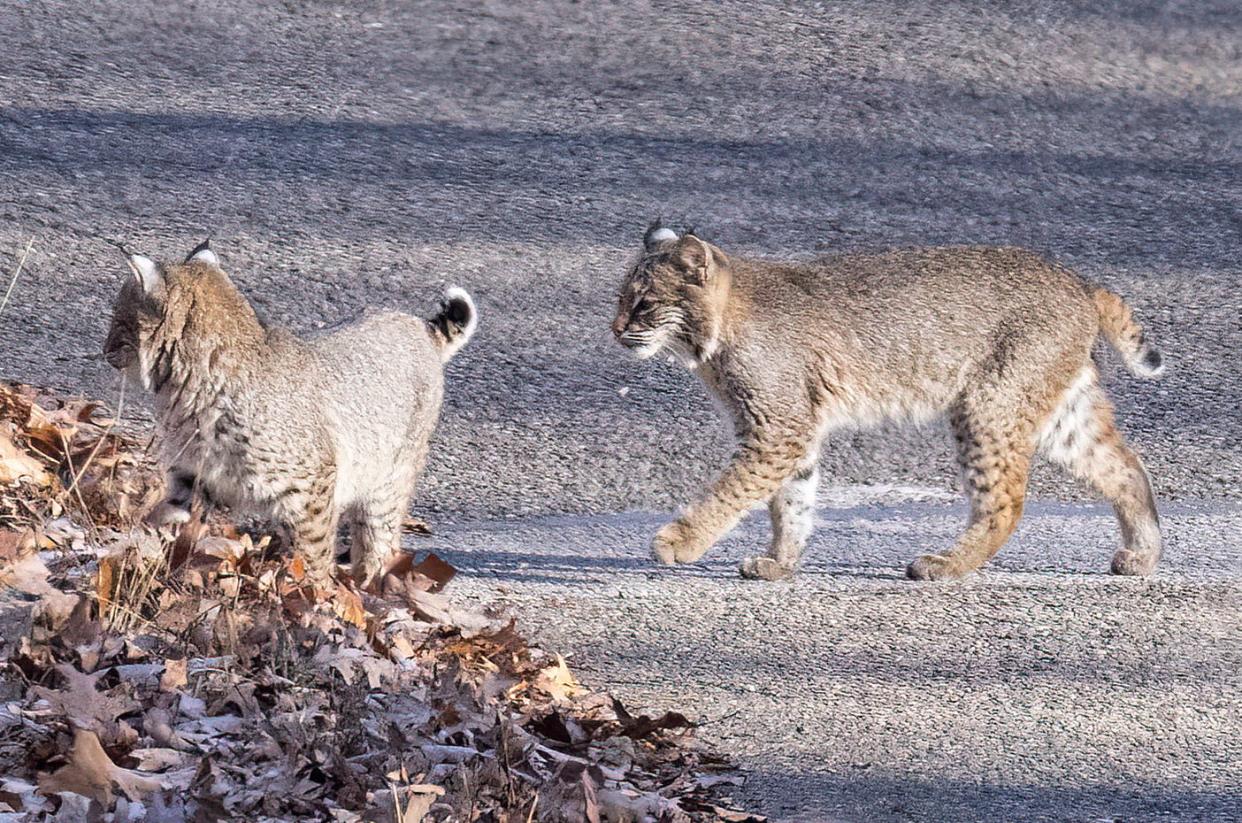Bobcats' return to Ohio's forests an environmental success story

Saturday, Nov. 19, started out nippy. I reached a remote area of southern Ohio’s Shawnee State Forest at dawn, the mercury at 13 degrees. Fitting, as I was after strange ephemeral ice formations known as frost flowers. I found those, the first that I had seen, but all finds this day would be eclipsed by a mammal.
The first critter that I saw was a gray fox. That was an omen of things to come.
After finding and photographing many frost flowers – icy garnishes that form around the bases of dittany plants – my mind turned toward birds. I bushwhacked into an old overgrown clearcut, camera and big lens in tow. Plenty of avian subjects were about – hermit thrushes, pileated woodpeckers, purple finches and more – but my luck in getting them in the lens was so-so.
A surprising sight
Eventually, I worked back toward the vehicle, and as I approached the sparsely traveled forest lane, I quieted my footfalls. Everything crosses roads, and it can pay dividends to peer up and down their lengths to see who may be about.
Stealth paid off big-time on this occasion. I crept near the lane and glanced down the hill. Not far off was an adult female bobcat leading two kittens across the road! I quickly set the tripod and camera rig down and started firing away.
Nature: Deep-diving scoters, found largely around the Great Lakes, spotted in central Ohio
Mirrorless cameras make no sound as the shutter is actuated, and the cats never made me. The mother did not linger, immediately heading about 10 feet up the wooded hillside. She began rooting around, and as I would later learn, opening the entrance to a maternal den site.
The two kittens tarried by the road’s edge, and they are watching mom in the accompanying photo. Kittens will be kittens, and they horsed around a bit, even exchanging a few air bats. In all, I got to watch them for over a minute before the family disappeared into their subterranean lair.
Bobcat population on the rebound
The resurgence of bobcats in Ohio is an environmental success story in an age of too many tales of woe. At the time of European settlement, the little cats (male 30-35 pounds, female 25-30 pounds) would have been common statewide. Jack Gottschang, in his 1981 book, "A Guide to the Mammals of Ohio," considered it unlikely there were reproducing bobcats in the state. Epic habitat loss, probably in tandem with early persecution by people, had severely reduced bobcat numbers in the eastern U.S.
In recent decades, bobcats have been making a comeback. The proliferation of trail cams has shed light on their increased numbers. It’s likely that all well-forested regions of Ohio have at least some bobcats, and in optimal sites, they may be at or near peak occupancy. The Ohio Division of Wildlife received 521 verified reports in 2021. From 1970 to the present, bobcats have been documented in 77 of our 88 counties, with most reports from the unglaciated hill country.
Nature: Blue jays' love for eating and burying acorns has birthed many a mighty oak tree
Most bobcat kittens are born in spring. The pair that I saw were only about half the size of their mom, and I asked biologist and bobcat expert Laura Hughes her opinion on their age. She feels it’s possible that something happened to the queen’s (female bobcat) spring litter. Young kittens are very vulnerable to predation in their first weeks. She likely bred again and had this pair around July, making them about 4-5 months old. They’ll stay with their mother for seven months or even longer, covering a home range that might be seven square miles or more. Their prey is mostly small mammals such as chipmunks, mice and rabbits.
Bobcats are a fascinating and important part of our natural heritage, and a positive indication of the recovery of forested ecosystems. Ohio was around 95% wooded at the time of settlement, which plummeted to perhaps 10-15% around the turn of the 20th century. Today, about one-third of the state is forested.
Until the mid-1800’s, two other wildcats occurred in Ohio: lynx, and cougar (mountain lion). These larger cats could not survive the human onslaught, and there is no hope of their reestablishment in Ohio. I and many other conservationists are pleased indeed that at least one of our trio of cats is making a comeback.
Naturalist Jim McCormac writes a column for The Dispatch on the first, third and fifth Sundays of the month. He also writes about nature at www.jimmccormac.blogspot.com.
This article originally appeared on The Columbus Dispatch: Nature: Bobcats making a comeback in Ohio forests

